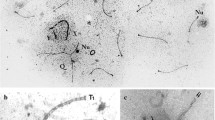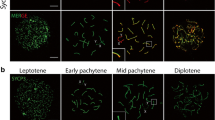Abstract
At the leptotene stage of meiotic prophase in Locusta spermatocytes (2n=22 telocentric autosomes + X-chromosome), each chromosome forms an axial core. The 44 ends of the autosomal cores are all attached to the nuclear membrane in a small region opposite the two pairs of centrioles of the juxtanuclear mitochondrial mass. At later stages of meiotic prophase, the cores of homologous chromosomes synapse into synaptinemal complexes. Synapsis is initiated near the nuclear membrane, in the centromeric and the non-centromeric ends of the chromosomes. Homologous cores have their attachment points close together and some cores are co-aligned prior to synapsis. At subsequent stages of zygotene, the number of synaptinemal complexes at the membrane increases, while the number of unpaired axial cores diminishes. At pachytene, all 11 bivalents are attached to the membrane at both ends, so that there are 22 synaptinemal complexes at the membrane near the centrioles. Because each bivalent makes a complete loop, the configuration of the classic Bouquet stage is produced. The X-chromosome has a poorly defined single core at pachytene which also attaches to the nuclear membrane. These observations are based on consecutive serial sections (50 to 100) through the centriolar zone of the spermatocytes. Labeling experiments demonstrated that tritiated thymidine was incorporated in the chromatin of young spermatocytes prior to the formation of the axial cores at leptotene. It is concluded that premeiotic DNA synthesis is completed well in advance of pairing of homologous chromosomes, as marked by the formation of synaptinemal complexes.
Similar content being viewed by others
References
Aldrich, H. C.: The ultrastructure of meiosis in three species of Physarum. Mycologia (Lancaster, Pa.) 59, 127–148 (1967).
Baker, T. G. and L. L. Franchi: The fine structure of oogonia and oocytes in human ovaries. J. Cell Sci. 2, 213–224 (1967).
Bauer, H.: Die Chromosomen von Tipula paludosa Meig. in Eibildung und Spermatogenese. Z. Zellforsch. 14, 138–193 (1931).
Brown, W. V. and S. M. Stack: Somatic pairing as a regular preliminary to meiosis. Bull. Torrey bot. Club 95, 369–378 (1968).
Carroll, G. and R. Dykstra: Synaptinemal complexes in Didymium iridis. Mycologia (Lancaster Pa.) 58, 166–169 (1966).
Coleman, J. R. and M. J. Moses: DNA and the fine structure of synaptic chromosomes in the domestic rooster (Gallus domesticus). J. Cell Biol. 23, 63–78 (1964).
Cooper, K. W.: Meiotic conjunctive elements not involving chiasmata. Proc. nat. Acad. Sci. (Wash.) 52, 1248–1255 (1964).
Darlington, C. D.: Recent advances in cytology, 2nd edit. London: Churchill 1937.
Engels, F. M., and A. F. Croes: The Synaptinemal complex in yeast. Chromosoma (Berl.) 25, 104–106 (1968).
Fawcett, D. W.: The fine structure of chromosomes in the meiotic prophase of vertebrate spermatocytes. J. biophys. biochem. Cytol. 2, 403–406 (1956).
Ford, E. H. R. and D. H. M. Woollam: Testicular chromosomes of Gallus domesticus. Chromosoma (Berl.) 15, 568–578 (1964).
Franchi, L. L. and A. M. Mandl: The ultrastructure of oogonia and oocytes in the foetal and neonatal rat. Proc. Roy. Soc. Lond. B 157, 99–114 (1962).
Galey, F. R. and S. E. G. Nilsson: A new method for transferring sections from the liquid surface of the trough through staining solutions to the supporting film of a grid. J. Ultrastruct. Res. 14, 405–410 (1966).
Gall, J. G.: Centriole replication. J.biophys. biochem. Cytol. 10, 163–193 (1961).
Grell, R. F.: Pairing at the chromosome level. J. cell. Physiol. 70, Suppl. 1, 89–112 (1967).
Grönberg, R., and A. Telkkä: Juxtanuclear changes during the early spermatogenesis in Lebistes reticulatus (Guppy). Z. Zellforsch. 84, 342–349 (1967).
Henderson, S. A.: Time of chiasma formation in relation to the time of deoxyribonucleic acid synthesis. Nature (London) 211, 1043–1047 (1966).
Kasha, K. J. and C. R. Burnham: The location of interchange breakpoints in barley. II. Canad. J. Genet. Cytol. 7, 620–632 (1965).
Lu, B. C.: Meiosis in Coprinus lagopus: a comparative study with light and electron microscopy. J. Cell Sci. 2, 529–536 (1967).
Luft, J. H.: Improvements in epoxy resin embedding methods. J. biophys. biochem. Cytol. 9, 409 (1961).
Maguire, M. P.: Evidence for homologous pairing of chromosomes prior to meiotic prophase in maize. Chromosoma (Berl.) 21, 221–231 (1967).
Maillett, P. L. and R. Folliot: Sur les ultrastructures chromosomiques de la méiose chez „Philaenus spumarius“ L. male (Homoptera, Cercopidae). C. R. Acad. Sci. (Paris) 260, 3486–3489 (1965).
McClung, C. E.: Synapsis and related phenomena in Mecostethus and Leptysma (Orthoptera). J. Morph. Physiol. 43, 181–265 (1927).
Meyer, G. F.: The fine structure of spermatocyte nuclei of Drosophila melanogaster. Proc. Europ. Reg. Conf. El. Microscopy, Delft, 2, 951–954 (1961).
- A possible correlation between the submicroscopic structure of meiotic chromosomes and crossing over. Electron microscopy 1964 (M. Titlbach, ed.) B, 461–462, Prague 1964.
Millonig, G.: A modified procedure for lead staining of thin sections. J. biophys. biochem. Cytol. 11, 736–739 (1961).
Moens, P. B.: The structure and function of synaptinemal complexes in Lilium longiflorum sporocytes. Chromosoma (Berl.) 23, 418–451 (1968).
—: The fine structure of meiotic chromosome pairing in the triploid Lilium tigrinum. J. Cell Biol. 40, 173–179 (1969a).
—: Multiple core complexes in grasshopper spermatocytes and spermatids. J. Cell Biol. 40, 542–551 (1969b).
- and, F. O. Perkins: Chromosome number of a small protist; an accurate determination. (In press.)
Moses, M. J.: Chromosomal structures in crayfish spermatocytes. J. biophys. biochem. Cytol. 2, 215–218 (1956).
—: The relation between the axial complex of meiotic prophase chromosomes and chromosome pairing in a salamander (Plethodon cinereus). J. biophys. biochem. Cytol. 4, 633–638 (1958).
- Synaptinemal complex. In: Ann. Rev. of Genetics (Annual reviews, Palo Alto) 2, 363–412 (1968).
Nebel, B. R. and E. M. Coulon: Enzyme effects on pachytene chromosomes of the male pigeon evaluated with the electron microscope. Chromosoma (Berl.) 13, 292–299 (1962).
Nebel, B. R. and E. M. Hackett: Synaptinemal complexes in primary spermatocytes of the mouse: the effect of elevated temperature and some observations on the structure of these complexes in control material. Z. Zellforsch. 55, 556–565 (1961).
Oksala, T.: Chromosome pairing, crossing over and segregation in meiosis in Drosophila melanogaster females. Cold Spr. Harb. Symp. quant. Biol. 23, 197–210 (1958).
Peacock, W. J.: Replication, recombination and chiasmata in Goniaea australasiae (Orthoptera, Acrididae). Genetics (in press).
Roth, T. F.: Changes in the synaptinemal complex during meiotic prophase in mosquito oocytes. Protoplasma (Wien) 61, 346–386 (1966).
Schin, K. S.: Core-Strukturen in den meiotischen und post-meiotischen Kernen der Spermatogenese von Gryllusdomesticus. Chromosoma (Berl.) 16, 436–452 (1965).
Smith, S. G.: Polarization and progression in pairing. II. Premeiotic orientation and the initiation of pairing. Canad. J. Res. 20, 221–229 (1942a).
—: Polarization and progression in pairing. III. Pachytene observations in Neodiprion (Hymenoptem). Canad. J. Res. 20, 368–379 (1942b).
Sotelo, J. R., and R. Wettstein: Electron microscope study on meiosis. The sex chromosome in spermatocytes, spermatids and oocytes of Gryllus argentinus. Chromosoma (Berl.) 15, 389–415 (1964).
—: Fine structure of meiotic chromosomes; comparative study of nine species of insects. Chromosoma (Berl.) 20, 234–250 (1966).
Sved, J. A.: Telomere attachment of chromosomes. Some genetical and cytological consequences. Genetics 53, 747–756 (1966).
Swift, H.: Quantitative aspects of nuclear nucleoproteins. Int. Rev. Cytol. 2, 1–76 (1953).
Sybenga, J.: The zygomere as hypothetical unit of chromosome pairing initiation. Genetica (s'Gravenhage) 37, 186–198 (1966).
Taylor, J. H. and R. D. McMaster: Autoradiographic and microphotometric studies of desoxyribose nucleic acid during microgametogenesis in Lilium longiflorum. Chromosoma (Berl.) 6, 489–521 (1954).
Underbrink, A. G., Y. C. Ting and A. H. Sparrow: Note on the occurrence of a synaptinemal complex at meiotic prophase in Zea mays L. Canad. J. Genet. Cytol. 9, 606–609 (1967).
Wenrich, D. H.: The spermatogenesis of Phrynotettix magnus,with special reference to synapsis and the individuality of the chromosomes. Museum Comp. Zool. Harvard Coll. Bull. 60, 57–132 (1916).
Wettstein, R. and J. R. Sotelo: Electron microscope serial reconstruction of the spermatocyte I nuclei at pachyteue. J. de Microsc. 6, 557–576 (1967).
White, M. J. D.: Animal cytology and evolution, 2nd edit. Cambridge: University Press 1954.
Woollam, D. H. M., E. H. R. Ford, and J. W. Millen: The attachment of pachytene chromosomes to the nuclear membrane in mammalian spermatocytes. Exp. Cell Res. 42, 657–661 (1966).
—, J. W. Millen, and E. H. R. Ford: Points of attachment of pachytene chromosomes to the nuclear membrane in mouse spermatocytes. Nature (Lond.) 213, 298–299 (1967).
Author information
Authors and Affiliations
Rights and permissions
About this article
Cite this article
Moens, P.B. The fine structure of meiotic chromosome polarization and pairing in Locusta migratoria spermatocytes. Chromosoma 28, 1–25 (1969). https://doi.org/10.1007/BF00325986
Received:
Accepted:
Issue Date:
DOI: https://doi.org/10.1007/BF00325986




